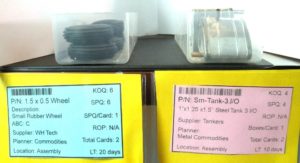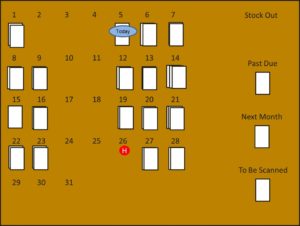Kanban Types & Triggers
Kanban, one of the primary Lean tools, is an inventory management system that relies on real-world inventory consumption (demand) to trigger replenishment signals (supply). Click here to read about kanban.
Components of a kanban solution: signals, quantity, & lead time
Kanban solutions consist of a specified number of signals, a standard order quantity, and a defined lead time. The number of signals determines the type of kanban solution being utilized, e.g., 2 cards, multiple cards, or 1 card. The timing of when a replenishment signal is issued determines the trigger timing for the solution, which can be break a bin, empty a bin, or in the middle of a bin.
A typical kanban solution might be 2 cards @ 100 pieces each, 4 cards @ 500 pieces each, or 1 spot on the floor for a 55-gallon drum.
The term lead-time demand refers to the expected consumption during one lead-time period. If an item has a lead time of 10 days and daily demand is 5, the lead-time demand is 50 pieces. Every kanban item’s solution must order enough inventory to cover the expected demand during the actual lead time, including any required safety stock for delivery or supply variation.
Regardless of the total number of signals or the timing of the triggers, when a kanban signal is sent there must be enough inventory on hand to cover the expected demand that will occur from that moment until the next replenishment order arrives. Figuring out these details is part of the complex process of calculating kanban solutions.
3 Types of kanban solutions
Once items are sorted into “on kanban” or “not on kanban,” the kanban items must be assigned a type of kanban solution.
Two card solutions are the standard or ideal kanban solution, which allows one card to be with on-hand inventory while the other is linked to a replenishment order that’s coming from the supplier. Conceptually, one card is linked to on-hand inventory while the other hangs on the kanban board.
A single card or 1-card solution is used when an item’s minimum order quantity (MOQ) exceeds the number of pieces that need to be ordered for a 2-card solution. For example, if an item has a lead-time of 10 days and daily demand is 10, we need to order 100 pieces to cover lead-time demand with zero safety stock. If the item has a minimum order quantity of 1,000 there’s no way to use 2 cards for this item because there would be piles of excess inventory. Instead, use 1 card and place a replenishment order when the on-hand balance gets down to no less than 100, which is the amount needed on the shelf when a new order is placed. One-card solutions are considered mid-point triggers because the card is not triggered at the beginning or end of the kanban bin.
Multi-card solutions have any number of kanban signals or cards, going to as low as one card and up to any number. (I’ve seen solutions with as many as 89 cards. Yes, it worked, but it’s a long story.) There are three specific circumstances that justify a multi-card kanban solution.
- If an item has seasonal or day-to-day demand variation that necessitates frequent resizing, a multi-card solution is deployed to make it easy to resize by adding or subtracting cards from the floor.
- If an item has a long lead time, a multi-card solution reduces on-hand inventory by breaking the order quantity into smaller batches than a 2-card solution would allow.
- An item with a maximum order quantity (MaxQ) that is less than the 2-card order quantity requires more than 2 cards. If an item’s 2-card solution requires an order quantity of 5,000 per card, but the maximum allowed order quantity is 2,500, we need more than 2 cards.
Trigger timing
Kanban signals are triggered at the beginning, end, or middle of a kanban bin. In this context, the word “bin” means the kanban order quantity, not the physical container. If we order 100 pieces in 2 boxes of 50, the bin is 100 pieces, not a box of 50.
Break a bin (BaB) means the card is triggered when the first piece is taken out of the kanban bin. The advantage to this method is that it can reduce inventory for 2-card solutions, but break a bin is very difficult to audit because kanban items only expect to have a card with on-hand inventory when the bin is full, and it’s difficult to tell the difference between a full bin and a bin that has consumed one piece.
Empty a bin (EaB) means the card is triggered he last piece is removed from the bin. It is the opposite of break a bin, so average inventory for a 2-card solution is higher that BaB, but EaB is easier to audit because every kanban item has a card associated with on-hand inventory, from 1 piece up to a full kanban bin.
Mid-point triggers only occur with 1-card solutions, as described above.
Need more info? Keep browsing this blog. Want specific expertise implementing kanban solutions in your organization? Contact Josette Russell today.



 Kanban is a repetitive loop
Kanban is a repetitive loop
